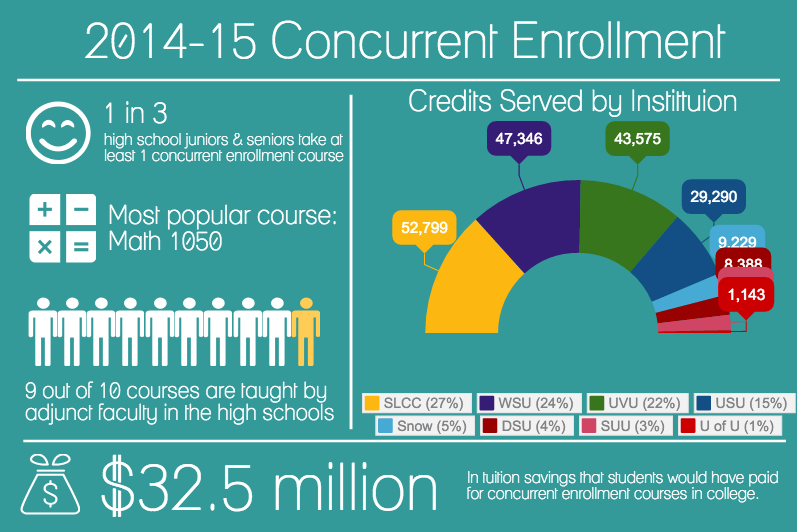Since 1985, Utah has provided an opportunity for prepared high school juniors and seniors to take college courses while still in high school. Through the Concurrent Enrollment program, students earn both high school credit for graduation and college credit corresponding to the first year at a college or university in the Utah System of Higher Education (USHE).
Student participation
In 2014-15, 28,551 students participated in concurrent enrollment – over ⅓ of all high school juniors and seniors in Utah. Concurrent enrollment credit is earned by students in all 41 school districts and 27 charter and alternative high schools. 54% of students participating in concurrent enrollment are female – consistent with past year enrollments.
College credit awarded
In 2014-15, participating students registered in 69,096 classes, earning 198,163 semester credits. Over ⅔ of the credit earned fulfilled general education requirements for college graduation – credit transferable among all eight USHE institutions. The top enrolling class is Math 1050, followed by English 1010. 21% of the credit earned is in STEM CTE courses.
Cost savings to students
Concurrent enrollment provides a significant cost savings opportunity for high school students in Utah who attend a USHE institution. It is estimated that Utah high school students would have paid $32.5 million in tuition for the 198,163 credits hours awarded in 2014-15. This amounts to anywhere between a $1,300 to $13,500 saved per student (depending on variables such as credits earned, status after graduation, and college enrollment). In recent years, the state legislature has allowed a small fee that a USHE institution may charge students. However, even with a small fee, concurrent enrollment serves as a significant scholarship opportunity for Utah high school students.
Course delivery methods
90% of concurrent enrollment credits are earned via courses taught in high schools with adjunct faculty. USHE institutions employ a variety of technologies to deliver concurrent enrollment courses. Weber State University’s and Salt Lake Community College’s programs are almost exclusively face-to-face instruction in the high school – the two institutions that enroll over half of all students participating in concurrent enrollment courses.
Conversely, roughly one-third of the credits earned through Utah Valley University and Utah State University and half of the credits earned at Snow College are faculty-taught via interactive video through the Utah Education Network – a critical factor in serving students more than in rural school districts.
College credit providers
Overall, 75% of concurrent enrollment credit is provided by three USHE institutions: Salt Lake Community College (27%), Weber State University (25%) and Utah Valley University (23%). Those three institutions serve 30 of the 41 school districts and 21 charter schools. Three school districts (Davis, Jordan, Weber) had students who earned credit from all eight USHE institutions.
College credit recipients: School districts
Students in Davis School district earned the most credit via concurrent enrollment (27,511), followed by Jordan (20,572), then Alpine school district (16,713). Over half of the college credit earned by students participating in concurrent enrollment were in just six school districts: Alpine, Cache, Davis, Granite Jordan and Weber school districts.

